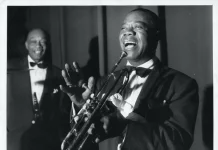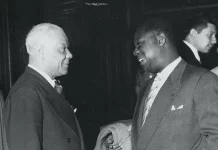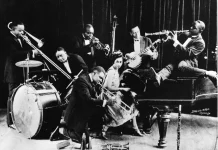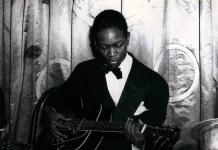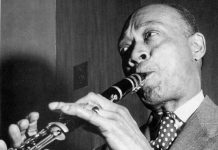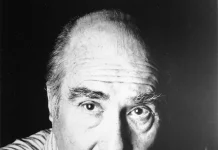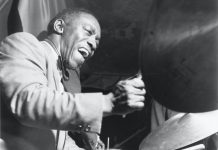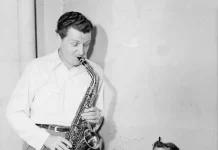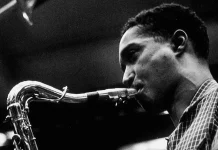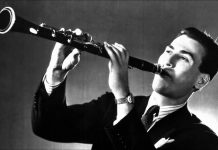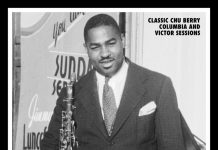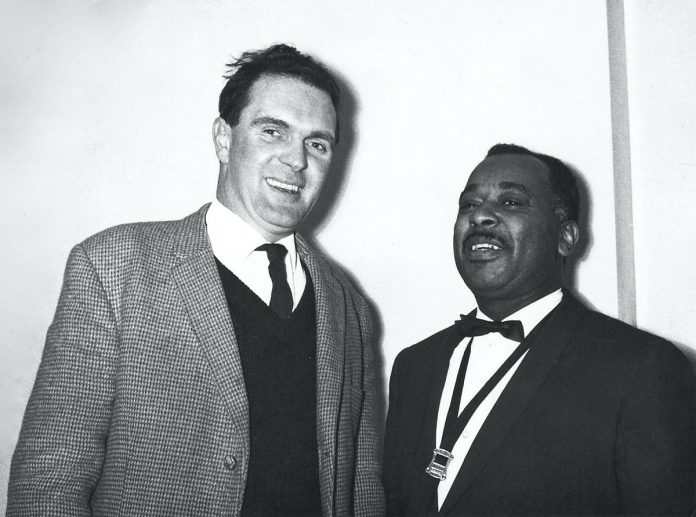
As he took the alto solo Johnny Hodges’s eyes swept the auditorium like beams from a lighthouse. The audience didn’t know he was counting.
“Eleven,” said Jimmy Hamilton as the Duke Ellington Orchestra trooped off stage for the interval. “Twelve,” grunted Johnny Hodges. “What was all that about?” I asked Hamilton. “Exits,” said Hamilton. “We get bored during concerts and one of the things we do is count the exits.”
Hamilton and Hodges were the leading figures in a rigid subculture which ran through the Ellington band and contrasted with the casual attitude to discipline within its ranks. The two were sometimes friends and always rivals. They battled with each other each night to see who would be last to take his seat when the band came on stage. The theory prevailed that whoever rushed to take his seat first was the man most afraid of losing his job. Eventually the whole band developed a reluctance to take to the stage and Ellington, a hopeless disciplinarian, couldn’t do much about it.
Hamilton was not casual about the music, however. He was probably the most dedicated musician in Ellington’s band. He was phlegmatic and fastidious about his clarinet-playing, and in this respect very different from his rival, the alto saxophonist Johnny Hodges, a soloist of genius but, unlike Hamilton, a poor reader.
Jimmy was born in Dillon, South Carolina on 25 May 1917 and grew up in Philadelphia where his father played in a brass band. Jimmy began on brass instruments and settled on alto and clarinet as a double.
Hamilton was five when his family moved to Philadelphia and his father, also a clarinet player, arranged for him to study piano and brass instruments. He joined the local band led by Frank Fairfax in 1934 as a trumpeter and played in the same section as the young Dizzy Gillespie and Charlie Shavers.
Hamilton’s inspirations: ‘I listened to Barney Bigard, Buster Bailey and Artie Shaw, but it was Benny who inspired me, and soon I could play many of his solos note for note’
Switching to clarinet a year or so later he began working with name bands. “I liked anything that was a challenge, and Benny Goodman was a great influence on me. I listened to Barney Bigard, Buster Bailey and Artie Shaw, but it was Benny who inspired me, and soon I could play many of his solos note for note.”
Hamilton continued his classical studies and as a result developed an immaculate jazz style, low on both vibrato and passion.
After spells with Jimmy Mundy, Benny Carter and Eddie Heywood he settled happily into the under-rated 1940 band of Teddy Wilson, alongside Bill Coleman, Benny Morton and Al Hall. Wilson used him often in a trio like the one that Wilson had helped make famous as the Benny Goodman Trio and in this setting it became difficult to distinguish Hamilton’s playing from that of his idol. Eventually Jimmy settled with the trio with Teddy at the Café Society, where he played until, according to Jimmy, John Hammond put pressure on Teddy to replace Jimmy with Ed Hall. (When Rex Stewart had refused some of his advice, Hammond had him blacklisted in New York for 18 months).
When Barney Bigard left Duke in 1943, Ellington knew who he wanted as replacement – another New Orleans man, Edmond Hall. But Ed had by now replaced Jimmy and was working with Teddy at Café Society and was reluctant to go to Duke. (Teddy resented Duke trying to pinch Ed, and in retaliation. made an offer to Johnny Hodges).
Ellington tried a couple of replacements who were not a success and then plumped for Hamilton because of his great musical skills rather than for his jazz method. On the face of it Hamilton’s style and tone were incompatible with Ellington’s music up to that point. Additionally the job required that Jimmy play tenor sax. Despite the fact that he had doubled on alto for many years, he seemed unhappy with the move to tenor.
“His double had been alto,” said Duke. “But now he had to make a switch, because our book called for clarinet doubling tenor. That he managed this perfectly was typical of Jimmy. He usually manages anything musical that he sets his mind to and there, I think, is the key to any attempt to describe him. He has the capacity to discipline himself and the diligence to study in order to learn. He practises endlessly and scarcely ever gets away from the school rules.”
“I didn’t like the tenor. I thought it was holding me back because of the difference in the mouthpiece. It was a handicap to my clarinet study. The character of the two instruments is quite different,” said Jimmy.
When he joined the Ellington band he instantly became one of its main voices and soon one of its most original arrangers.
His fastidious clarinet tone from his training at Juilliard gave a new sound to the band and caused some controversy amongst the Duke’s followers. His predecessor Barney Bigard’s fat and voluptuous clarinet sound had graced the Ellington band for 14 years when he left in 1942.
Hamilton developed a rugged, almost rhythm-and-blues way of playing the tenor which was far removed from the poise of his clarinet work. “The characters of the two instruments are quite different,” he qualified. “The tenor is more flexible so far as bending notes is concerned, and it’s very easy to play so you are less tense and can take more liberties.”
His smooth clarinet detached him from the rest of the band, and Ellington had to write music to accommodate him. Hamilton, by now one of the four outstanding clarinettists in jazz, became a composer of substance and with Ellington wrote Air-Conditioned Jungle (1947) to feature a daunting display of his orthodox style. Later he contributed Ad Lib On Nippon and his own concerto-like feature Clarinet Melodrama. He was also responsible for introducing the bebop influence into the band and his arrangement of and feature on Honeysuckle Rose used lines borrowed from Charlie Parker.
Hamilton’s mere 25 years with Duke still qualified him as a senior member and, in the code adhered to by the musicians, guaranteed him one of the four front seats on the band bus. The others were occupied by Hodges, Lawrence Brown and Russell Procope. The baritone saxist Harry Carney and Ellington himself travelled in Carney’s car.
“We had this one guy who used to drive the bus sideways,” said Hamilton. “Used to sit up there with his feet out in the aisle. I guess he was afraid he was going to miss something going on in the bus. We used to call him ‘Old Side Saddle’, and he sure scared me some, driving that way.”
During his time with Ellington he studied flute and became extremely proficient, although Ellington never asked him to play it with the band (Ellington later used the instrument when Norris Turney played it).
Hamilton left Ellington in 1968 when he won a substantial first prize in a lottery. He and his wife moved to St Thomas in the Virgin Islands, where he taught clarinet in public schools and played in a local hotel. He headed the Downbeat poll as clarinettist of the year in 1969.
In later years he gave up the clarinet as a regular instrument and when he was called upon to play it, had considerable difficulty getting back into shape. “When he flew over to New York to play with the Lincoln Center Orchestra in the mid-eighties”, recalled Joe Temperley, “he was usually a quarter-tone flat when he arrived and it used to take him a week to get that sorted out.” The illustrious sax section in that band included, apart from Hamilton and Temperley, Norris Turney and Joe Henderson.
During the 80s Hamilton worked again with the Ellington band, led now by Duke’s son Mercer, and toured Europe, briefly as a soloist. I met him again at the Ellington Convention held at Oldham in 1988 but illness prevented him from accepting an invitation to the following year’s similar meeting in Stockholm. He died on the island of St Croix on 20 September 1994.

